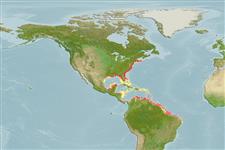Common names from other countries
>
Eupercaria/misc (Various families in series Eupercaria) >
Sciaenidae (Drums or croakers)
Etymology: Menticirrhus: Latin, mentum = beard, chin + Latin, cirrus = curly.
More on authors: Bloch & Schneider.
Environment: milieu / climate zone / depth range / distribution range
Ökologie
seewasser; brackwasser demersal; tiefenbereich 10 - ? m. Subtropical; 43°N - 11°S
Western Atlantic: Massachusetts to southern Florida in USA and Gulf of Mexico to Yucatan in Mexico.
Length at first maturity / Size / Gewicht / Alter
Maturity: Lm 25.6 range ? - ? cm
Max length : 46.0 cm TL Männchen/unbestimmt; (Ref. 7251); common length : 30.0 cm TL Männchen/unbestimmt; (Ref. 3702); max. veröff. Gewicht: 1.1 kg (Ref. 40637); max. veröff. Alter: 4 Jahre (Ref. 127588)
Adults occur usually in shallow coastal waters over sand to sandy mud bottoms. Common in the surf zone and in estuaries. Juveniles may enter tidal rivers and creeks of low salinity. Feed mainly on worms and crustaceans. An excellent food fish.
Robins, C.R. and G.C. Ray, 1986. A field guide to Atlantic coast fishes of North America. Houghton Mifflin Company, Boston, U.S.A. 354 p. (Ref. 7251)
IUCN Rote Liste Status (Ref. 130435)
CITES (Ref. 128078)
Not Evaluated
Bedrohung für Menschen
Harmless
Nutzung durch Menschen
Fischereien: weniger kommerziell; Sportfisch: ja
Mehr Information
ReferenzenAquakulturAquakultur ProfilZuchtlinienGenetikElectrophoresesVererbbarkeitKrankheitenVerarbeitungMass conversion
PartnerBilderStamps, Coins Misc.LauteCiguateraGeschwindigkeitSchwimmstilKiemenoberflächeOtolithsGehirngrößeSehfähigkeit
Tools
Zusatzinformationen
Download XML
Internet Quellen
Estimates based on models
Preferred temperature (Ref.
115969): 11.2 - 27.6, mean 24.2 (based on 232 cells).
Phylogenetic diversity index (Ref.
82804): PD
50 = 0.5020 [Uniqueness, from 0.5 = low to 2.0 = high].
Bayesian length-weight: a=0.00776 (0.00477 - 0.01264), b=3.04 (2.91 - 3.17), in cm Total Length, based on LWR estimates for this species & (Sub)family-body (Ref.
93245).
Trophic level (Ref.
69278): 3.6 ±0.5 se; based on diet studies.
Widerstandsfähigkeit (Ref.
120179): hoch, Verdopplung der Population dauert weniger als 15 Monate. (K=0.5).
Fishing Vulnerability (Ref.
59153): Low to moderate vulnerability (26 of 100).
Climate Vulnerability (Ref.
125649): Moderate vulnerability (43 of 100).
